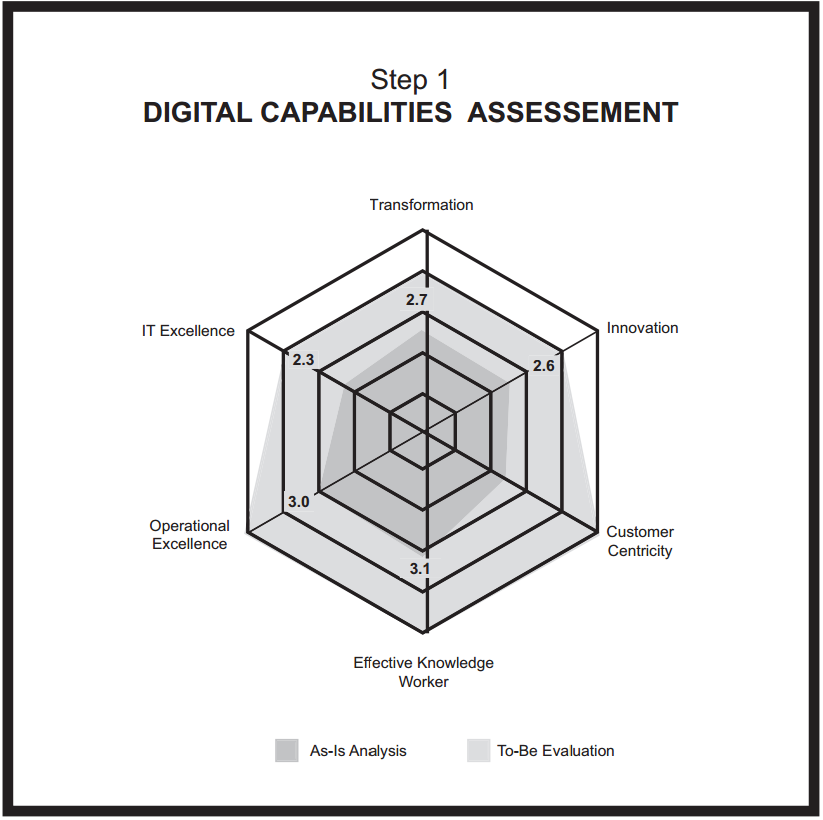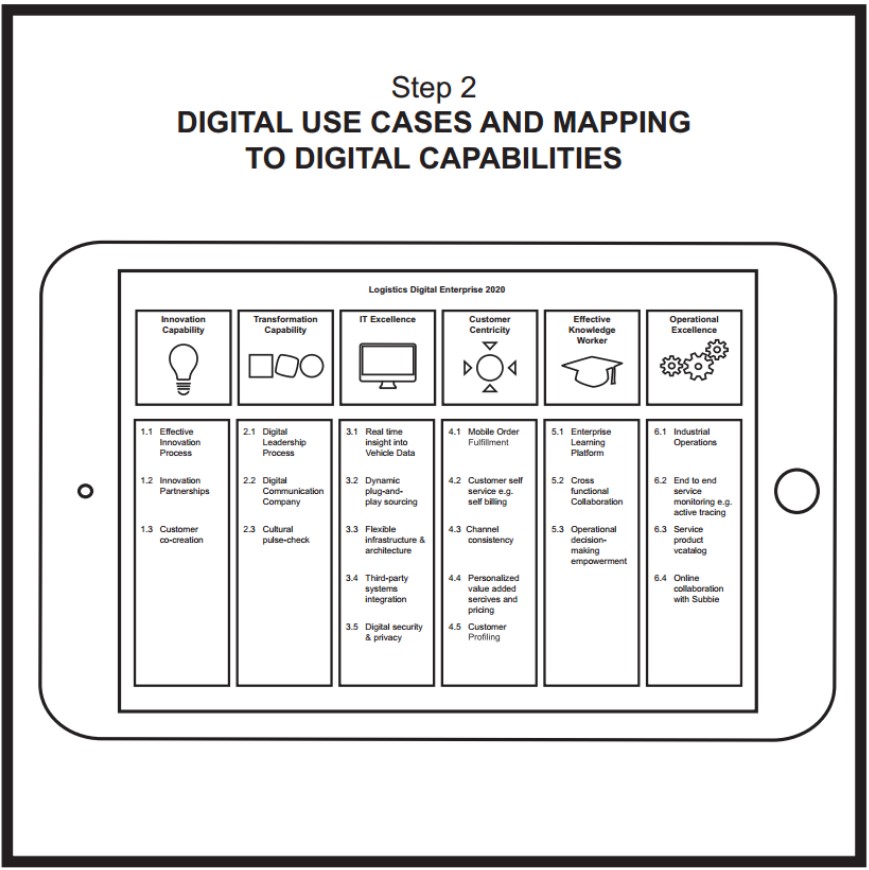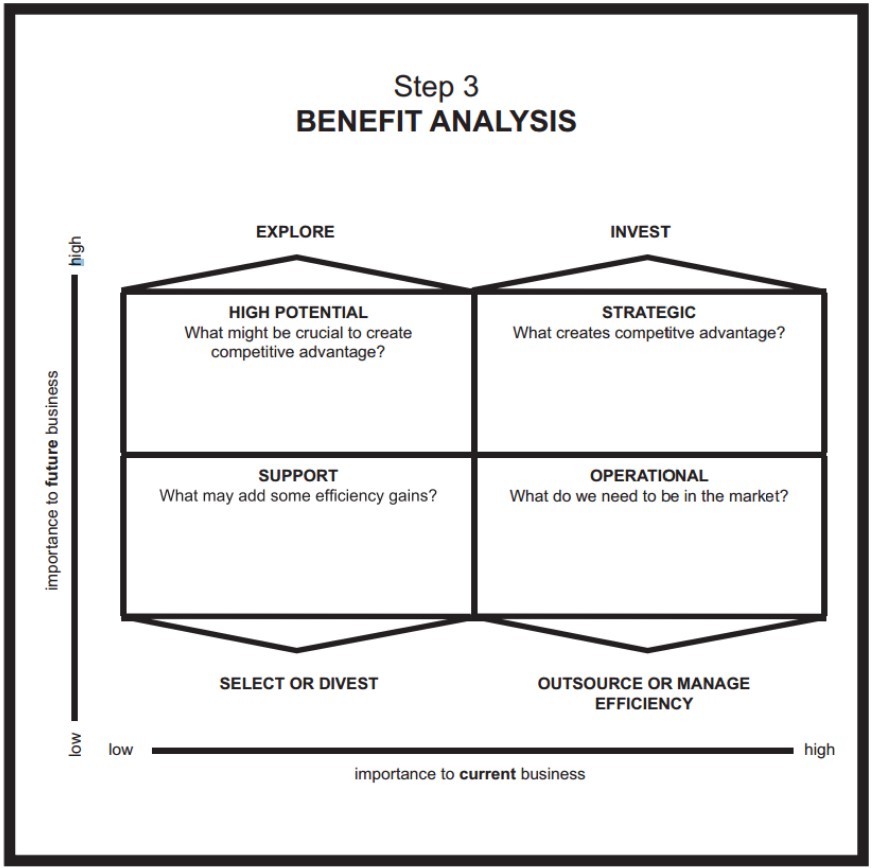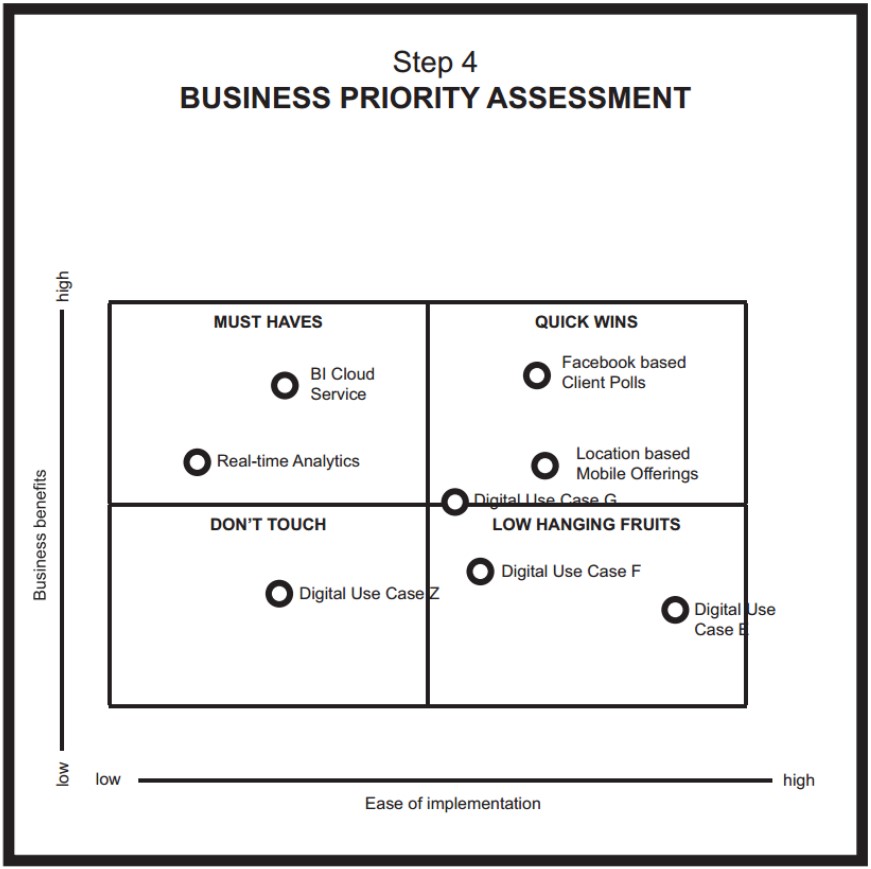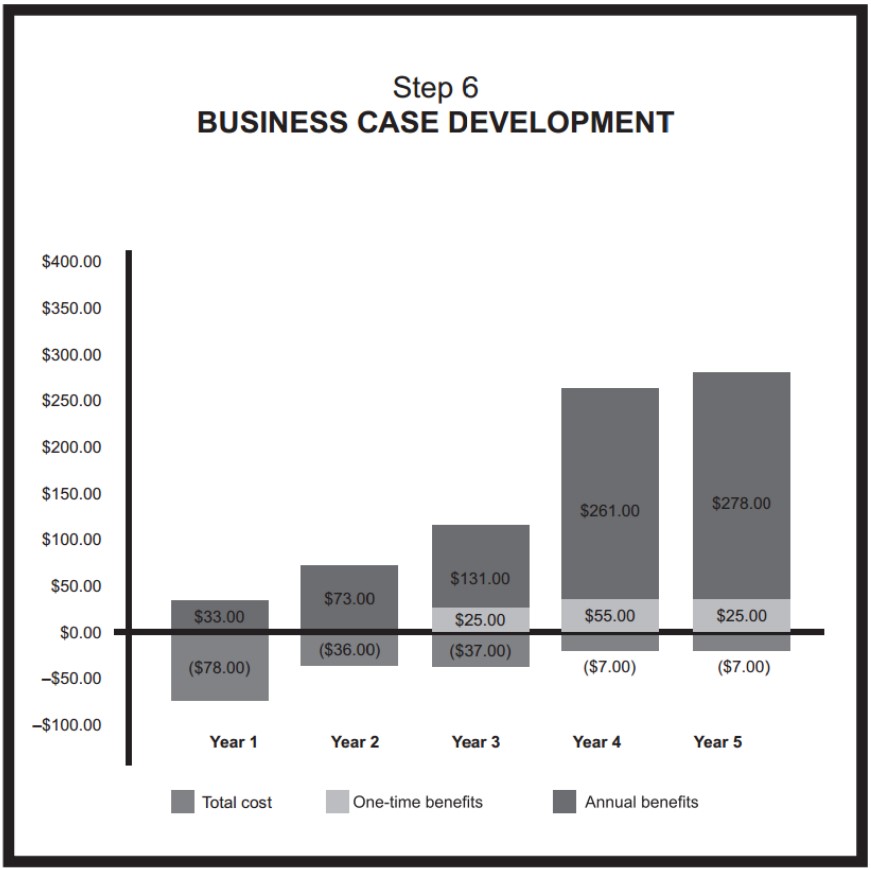6 Digital Transformation Steps
There are six logical digital transformation steps organisations can follow as a structured approach to digital transformation. They allow organisations to break down a complex process into smaller, manageable tasks and help ensure that all necessary areas of the organisation are involved and aligned.
By following a step-by-step process like this, organisations can identify and address any potential roadblocks or challenges early on, which can increase the likelihood of success. A structured approach also helps digital transformation teams measure progress and make any necessary adjustments along the way.

What is Digital Transformation?
Digital transformation is the process of utilising digital technologies to fundamentally change how a business operates, delivers value to customers, and engages with stakeholders. It involves the adoption of digital technologies such as cloud computing, artificial intelligence, the Internet of Things, and data analytics to streamline operations, enhance customer experience, and create new business models.
Digital transformation aims to create new opportunities and value for an organisation and improve its overall performance, agility, and competitiveness in a rapidly changing digital landscape.
Why is Digital Transformation Important?
Digital transformation is important for many reasons, including:
Increased efficiency:
By streamlining processes and leveraging technology, digital transformation can improve efficiency and productivity, ultimately leading to cost savings and improved customer satisfaction.
Greater agility
Digital transformation allows businesses to adapt more quickly to changing market conditions and customer needs, enabling them to stay competitive in a rapidly evolving business landscape.
Enhanced customer experience
Digital technologies can help businesses better understand and serve their customers, leading to improved customer experience and loyalty.
Access to new markets
Digital transformation can enable businesses to reach new markets and expand their customer base by leveraging digital channels.
Innovation
Digital transformation can help businesses unlock new sources of value and drive innovation by enabling the development of new products and services.
Digital transformation is a critical process for businesses looking to stay competitive, improve customer experience, and drive innovation in today's digital age.
What are the Top 3 Trends of Digital Transformation?
As of 2023, some of the top trends in digital transformation include:
Artificial Intelligence and Machine Learning
Businesses are using Artificial Intelligence (AI) and Machine Learning (ML) to improve automation, decision-making, and customer experience. Artificial Intelligence and Machine Learning are two related but distinct technologies that are increasingly important in today's digital age.
Artificial Intelligence refers to the simulation of human intelligence in machines, allowing them to perform tasks that would normally require human-level cognition, such as learning, decision-making, and problem-solving. Machine Learning is a subfield of Artificial Intelligence that involves the use of algorithms to allow machines to learn from data, automatically improving their performance without being explicitly programmed.
Artificial Intelligence and Machine Learning L are being used in a wide range of applications, from autonomous vehicles and virtual assistants to fraud detection and predictive maintenance. They are also being used to develop new products and services, such as personalised recommendations and medical diagnoses, that were not previously possible.
As these technologies continue to advance, they have the potential to transform many industries and aspects of our daily lives. However, there are also concerns about the ethical implications of Artificial Intelligence and Machine Learning, such as bias and privacy issues, that need to be carefully considered and addressed.
Internet of Things
As more devices become connected to the internet, businesses are using IoT to collect data and automate processes, resulting in greater efficiency and improved customer experiences.
The Internet of Things (IoT) refers to a network of physical objects or “things” that are embedded with sensors, software, and connectivity, enabling them to collect and exchange data. These objects can range from everyday devices such as smartphones, cars, and home appliances to industrial equipment such as turbines and pipelines.
The data collected by these devices can be analysed to provide insights and drive improvements in efficiency, productivity, and overall performance. IoT has the potential to transform industries such as healthcare, transportation, manufacturing, and energy by enabling real-time monitoring, predictive maintenance, and other applications that improve operational efficiency and customer experience.
Cloud Computing
The adoption of cloud computing has allowed businesses to access new technologies and services that can be rapidly deployed and scaled as needed, reducing costs and improving agility.
Cloud computing is the delivery of computing services, including servers, storage, databases, networking, software, analytics, and intelligence, over the internet (“the cloud”). Cloud computing provides access to a shared pool of computing resources that can be quickly provisioned and released with minimal management effort or service provider interaction. This enables individuals and organisations to use computing resources on an as-needed basis and pay for only what they use.
Cloud computing can help reduce infrastructure and maintenance costs, increase business agility and flexibility, and enable more rapid innovation and scaling of services. Some popular cloud computing providers include Amazon Web Services, Microsoft Azure, and Google Cloud Platform.
What are the 4 Main Areas of Digital Transformation?
The four main areas of digital transformation are:
Customer Experience
This involves using digital technologies to enhance and personalise the customer experience, such as through improved user interfaces, chatbots, and customer data analysis.
Digital technologies are enabling organisations to collect customer data and use it to gain insights into customer behaviour and preferences, personalise interactions, and anticipate customer needs. For example, companies can use customer data to create targeted marketing campaigns, provide personalised recommendations, and offer proactive customer service.
By leveraging digital technologies to enhance customer experience, organisations can build stronger relationships with customers, improve customer loyalty, and drive revenue growth. Customer experience is a critical component of digital transformation, as it enables organisations to stay competitive in a rapidly evolving business landscape.
Operational Processes
This involves using digital technologies to improve internal processes and operational efficiencies, such as through automation, cloud computing, and data analytics.
Operational processes play a critical role in digital transformation, as they are the core of business activities that drive growth and success. Digital transformation can help optimise operational processes by automating repetitive tasks, reducing manual errors, and improving the speed and accuracy of data processing.
By leveraging digital technologies like the Internet of Things (IoT), cloud computing, and artificial intelligence (AI), businesses can create more efficient and effective operational processes. This can result in better decision-making, increased productivity, and cost savings. Digital transformation can also enable businesses to be more agile and responsive to changes in the market, customer needs, and emerging technologies.
Business Models
This involves using digital technologies to create new business models or modify existing ones, such as through e-commerce, subscription-based services, or digital platforms.
Digital transformation has revolutionised traditional business models across a variety of industries. Companies are leveraging new technologies and digital tools to create innovative products, services, and business models that deliver enhanced value to customers. In the digital age, the focus is on creating value for customers through customised solutions and personalised experiences. This has given rise to new business models such as subscription-based services, sharing economy, and platform-based models.
Companies are also exploring digital marketplaces, e-commerce, and social media to drive customer engagement and increase revenue. Digital transformation has made it possible for businesses to operate with greater agility and efficiency, and has become an essential tool for remaining competitive in a rapidly evolving business landscape.
Organisational Culture
This involves creating a culture of innovation and digital fluency within the organisation, and enabling employees to adapt and thrive in a rapidly changing digital landscape.
Organisational culture in the context of digital transformation refers to the shared values, beliefs, attitudes, and behaviours that shape the way people work and interact within an organisation as it undergoes digital transformation. A positive culture that fosters innovation, collaboration, agility, and adaptability is essential for driving successful digital transformation.
A culture of continuous learning and experimentation can help organisations keep pace with the rapidly changing business environment and stay ahead of the competition. The right culture can also help organisations attract and retain talent that is critical to executing a successful digital transformation strategy.
6 Digital Transformation Steps You Can Start Today
Now let's look at the 6 digital transformation steps you can start today. These are not random steps. They are based on the Digital Capability Framework which means there is a rich body of knowledge accompanying each step.
Step 1 – Perform digital capabilities assessment
To begin with, it is essential for your organisation to have a good understanding of how digital technology is currently impacting it. By using the Digital Capability Maturity Models, your organisation can benchmark itself against well-defined industry standards.
Step 2 – Establish digital use cases
The utilisation of technology has varying impacts on each of the six Digital Capabilities. Consequently, it is important to define the relevant Digital Use Cases based on the results of the digital maturity analysis in step 1.
Step 3 – Conduct benefit analysis of use cases
After defining the Digital Use Cases, the analysis of the associated benefits needs to be conducted.
Step 4 – Agree business priorities
Your organisation can benefit from each Digital Use Case in different ways, with some having a significant impact and others addressing smaller issues. Prioritising the digital transformation requires determining the importance of each Digital Use Case.
Step 5 – Develop implementation roadmap
Once your organisation has a comprehensive understanding of the business impact and implementation requirements of each individual Digital Use Case, the next step is to establish the digital transformation roadmap for the upcoming three to five years.
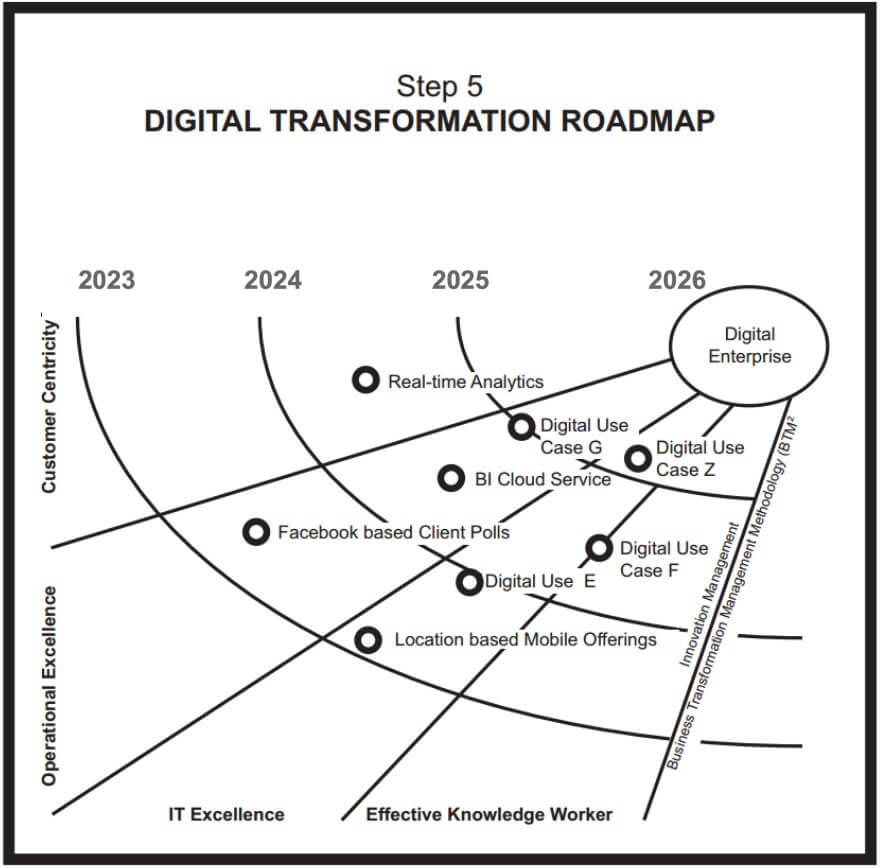
Step 6 – Establish business cases
A final step involves developing and evaluating the business cases for the Digital Use Cases to determine their feasibility and potential return on investment.
Image Source: Taylor & Francis

